Cloud Repatriation: Why Workloads Are Moving Off AWS in 2026
The narrative of the last decade has been dominated by a one-way migration to the public cloud. Enterprises stampeded toward providers like AWS, driven by the promise of infinite scalability, agility, and a “cloud-first” ideology. However, the operational realities of running extensive workloads in the public cloud have begun to reveal a more complex picture.
A strategic rebalancing is underway, and it’s called cloud repatriation. This isn’t a retreat; it’s a calculated advance toward a more optimized, “cloud-appropriate” infrastructure model.
The trend is undeniable. A 2024 Barclays CIO survey found that 86% of Chief Information Officers plan to move at least some public cloud workloads back to private cloud or on-premises environments.
Further, an IDC report from the same year indicates that nearly 80% of organizations expect to repatriate compute and storage resources within the next year. Companies like 37signals (formerly Basecamp) have documented their exit from the public cloud, framing the move not as a step backward but as an evolution toward modern, more efficient private infrastructure.
This guide will explore the technical and financial drivers behind this shift away from public cloud monocultures.
We will dissect the primary reasons organizations are leaving AWS, from staggering costs to performance bottlenecks, and provide a clear framework for evaluating if a hybrid cloud strategy is the right path for your enterprise.
The Rise of Cloud Repatriation
The initial rush to the cloud, often accelerated during the pandemic, led many organizations to move “too much, too quickly.” Now, with years of operational data, a more nuanced understanding of total cost of ownership (TCO) is emerging. According to Flexera’s 2025 State of the Cloud Report, managing cloud spend is the top challenge for 84% of organizations. This financial pressure is a primary catalyst for re-evaluating which workloads truly belong in the public cloud.
Cloud repatriation involves moving applications or data from a public cloud environment back to a privately-owned data center, a colocation facility, or a private cloud. The goal isn’t necessarily a full exit but a strategic reallocation of resources to their most logical and cost-effective home. Companies are realizing that the elasticity and pay-as-you-go model of public cloud, while beneficial for certain workloads, becomes a significant financial drain for stable, predictable applications.

Escaping the Cost Trap of AWS Lock-In
One of the most significant drivers of repatriation is the desire to escape the financial and technical constraints of vendor lock-in, particularly with AWS. While the public cloud offers vast service catalogs, deep integration with proprietary APIs and services creates dependencies that are difficult and expensive to untangle.
The Problem with Egress Fees
A major component of AWS lock-in is the high cost of data egress. Transferring data out of AWS is notoriously expensive. For instance, moving just one petabyte (PB) of data from AWS S3 can incur egress fees ranging from $90,000 to $120,000. These prohibitive costs create a powerful disincentive to move data, effectively trapping customers within the AWS ecosystem and limiting their ability to adopt multi-cloud or hybrid strategies. When 37signals decided to leave the cloud, AWS reportedly waived $250,000 in egress fees—a clear indicator of the scale of these charges.
Cost Savings Beyond Egress
The savings from cloud repatriation extend far beyond avoiding egress fees. For workloads with consistent and predictable resource needs, the public cloud premium can be substantial, often 30-50% higher over time compared to equivalent private infrastructure. 37signals projected saving $10 million over five years by moving their workloads on-premises.
Modern private infrastructure, like that offered by Hivelocity, provides predictable, flat-rate pricing, eliminating the surprise bills that plague cloud users. Close to 50% of cloud buyers reported spending more than they expected in 2023, a problem that repatriation directly addresses.
Optimizing for Performance and Latency
Cost is not the only factor. For many applications, performance is paramount. Public cloud environments are multi-tenant by nature, which can lead to resource contention and unpredictable performance, often referred to as the “noisy neighbor” problem.
Repatriating specific workloads to dedicated hardware can yield significant performance improvements. This is especially true for:
- I/O-Intensive & Latency-Sensitive Applications: Workloads like high-performance computing (HPC), real-time analytics, and large databases demand consistent, low-latency access to storage and compute resources that dedicated infrastructure can provide more reliably.
- Data-Intensive Workloads: Applications that process large volumes of data can achieve more consistent and lower-latency networking on dedicated infrastructure compared to general-purpose cloud networks. In fact, a recent study found that 53% of organizations experienced faster application performance after repatriation.
Enhancing Security and Compliance
While public cloud providers offer robust security tools, maintaining control over data sovereignty and compliance is a growing concern for many enterprises. Repatriating sensitive data allows organizations to exert full control over their security posture and ensure compliance with industry regulations like HIPAA or GDPR.
By bringing workloads back in-house or to a trusted private cloud provider, businesses can implement bespoke security protocols that are not possible in a shared public environment. This direct control is why 51% of organizations cite data security and privacy as a top driver for repatriation. The results speak for themselves: an overwhelming 92% of organizations reported an improved overall security posture after repatriation.
Adopting a Hybrid Cloud Strategy
For most enterprises, cloud repatriation does not mean a complete abandonment of the public cloud. Instead, it leads to the adoption of a hybrid cloud strategy, where workloads are placed in the environment best suited to their needs. Today, approximately 70% of businesses are embracing this balanced approach.
- Public Cloud: Ideal for workloads with variable demand, such as development/testing environments, customer-facing web applications with fluctuating traffic, and disaster recovery.
- Private Cloud/On-Premises: Best suited for stable, predictable workloads like large databases, core business applications, and data-intensive analytics platforms where performance and cost-efficiency are critical.
This “cloud-appropriate” model allows organizations to leverage the best of both worlds—the scalability of the public cloud and the cost, performance, and control of private infrastructure.
Your Cloud Repatriation Checklist
Planning a move off AWS requires careful consideration. A successful repatriation project hinges on a thorough assessment and a phased migration plan.
- Workload Assessment:
- Identify which applications are prime candidates for repatriation. Look for stable, predictable workloads with high data transfer or consistent compute/storage demands.
- Analyze the current TCO for these workloads on AWS, including compute, storage, data transfer, and egress fees.
- Financial Analysis:
- Calculate the projected cost of running these workloads on private infrastructure. Factor in hardware, software, colocation, and operational costs.
- Determine the break-even point and long-term ROI. Remember to account for the one-time migration costs.
- Infrastructure Selection:
- Choose the right infrastructure model: on-premises data center, colocation, or a private cloud provider like Hivelocity.
- Ensure the selected environment meets your performance, security, and compliance requirements.
- Migration Planning:
- Develop a detailed migration plan with clear timelines and responsibilities.
- Address application dependencies and plan for any necessary architectural changes. Migrating applications built on proprietary AWS services may require significant refactoring.
- Execution and Optimization:
- Execute the migration in phases to minimize disruption.
- Monitor performance and costs post-migration to validate the business case and identify further optimization opportunities.
Build Your Modern Infrastructure with Hivelocity
The conversation around cloud is maturing. A “cloud-first” approach is giving way to a more pragmatic “cloud-appropriate” strategy. As organizations scrutinize their cloud spend and demand greater control, cloud repatriation is emerging as a critical tool for IT optimization. Moving off AWS is no longer a fringe idea; for many, it’s the next logical step in their infrastructure journey.
Hivelocity Enterprise Cloud provides a powerful alternative to the public cloud giants. We offer modern private infrastructure with predictable pricing, no egress fees, and the granular control you need to optimize performance and security. Our expert support team and seamless migration services ensure a smooth transition, allowing you to build a resilient, cost-effective hybrid cloud strategy.


